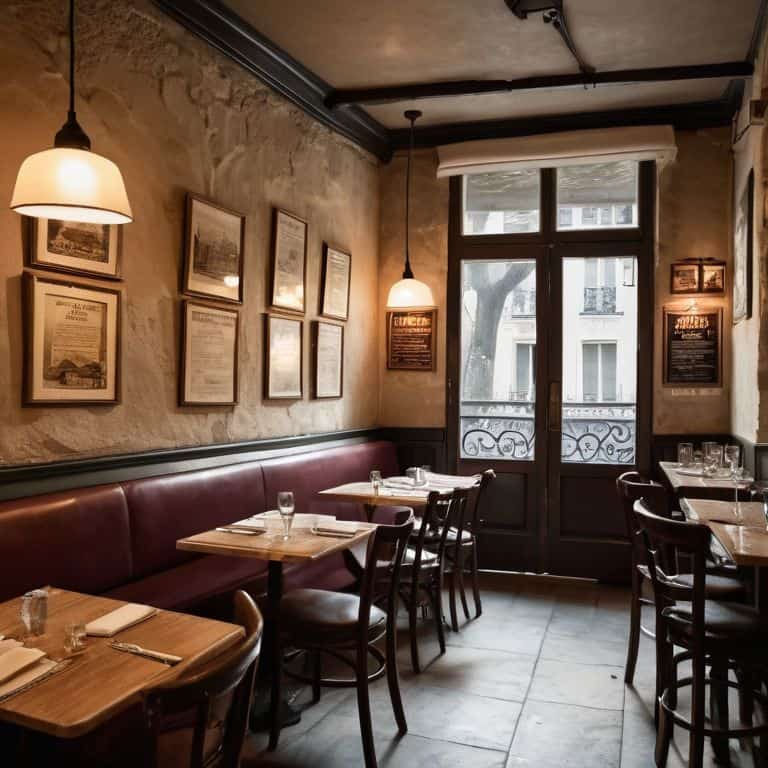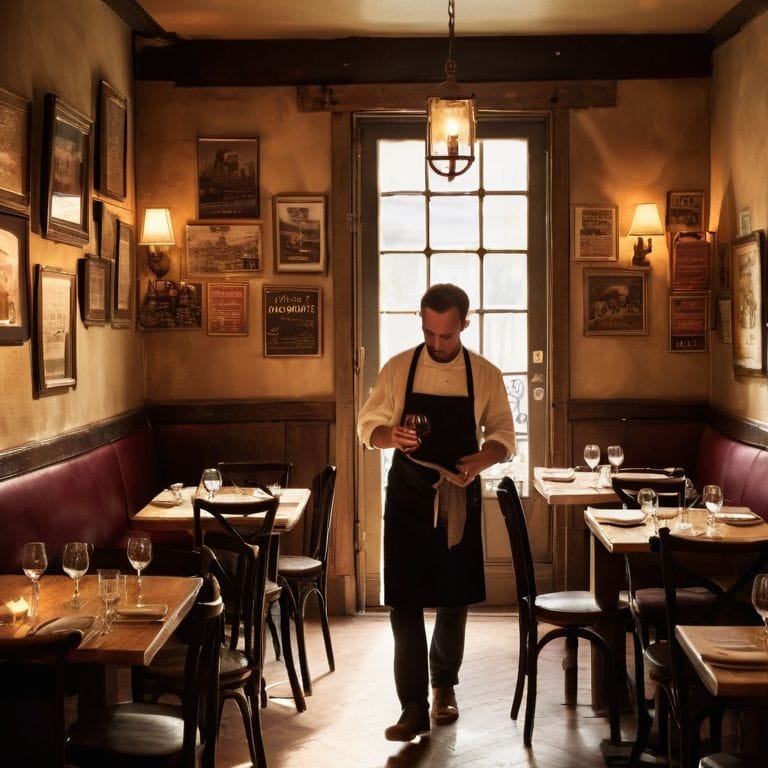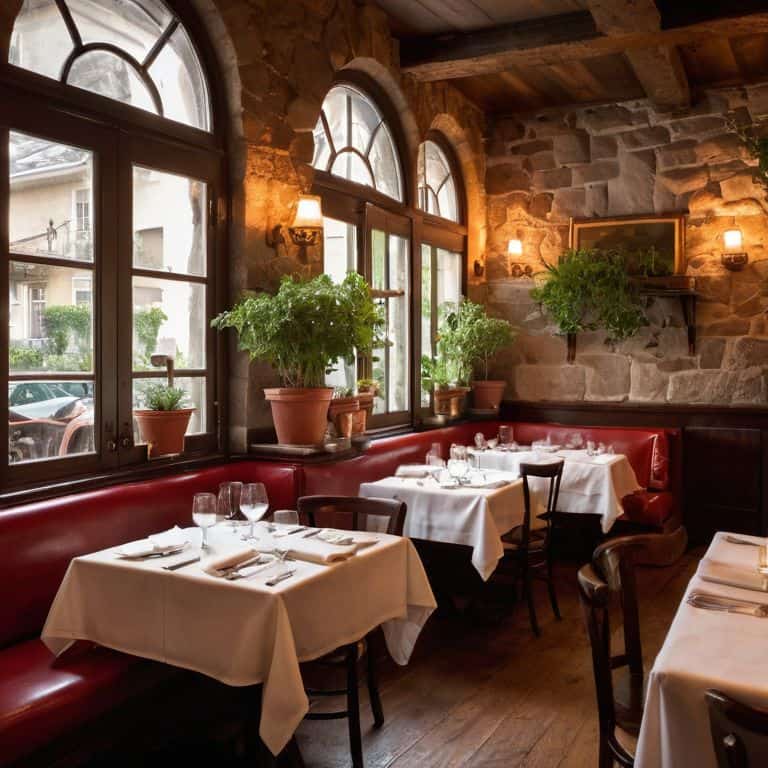As I sit here, sipping a rich coffee and savoring the flavors of a perfectly flaky croissant, I’m reminded of the countless times I’ve been asked what is a classic French bistro. The answer, much like the cuisine itself, is often shrouded in misconception and overcomplicated flair. For me, the true essence of a classic French bistro lies not in the fancy restaurants or haute cuisine, but in the cozy, unassuming eateries that line the streets of Paris, where the smell of freshly baked bread and simmering stews wafts through the air, enticing passersby to come and experience the real France.
In the following pages, I promise to take you on a journey through the unassuming doors of these beloved institutions, where the art of French cuisine is still practiced with love and devotion. I’ll share with you my own experiences, gathered from years of traveling and immersive culinary adventures, to provide a genuine, no-nonsense guide to understanding what makes a classic French bistro truly special. From the hearty dishes to the warm atmosphere, I’ll show you that the essence of a classic French bistro is not just about the food, but about the people, the culture, and the joie de vivre that comes with sharing a meal with others.
Table of Contents
Discovering Classic French Bistros

As I wandered through the charming streets of Paris, I stumbled upon a quaint little spot that embodied the essence of a traditional french bistro decor. The wooden tables, vintage posters, and soft lighting all contributed to an authentic french bistro atmosphere that made me feel like I was in for a treat. I had heard of this bistro, one of the famous french bistros in Paris, and was eager to try their take on classic dishes.
The menu read like a love letter to French cuisine, with classic french bistro menu items like escargots, steak tartare, and confit de canard. I opted for the latter, and as I waited for my food to arrive, I couldn’t help but think about the history of french bistros. These establishments have been a staple of French dining for centuries, offering a unique blend of comfort food and elegant service.
As I took my first bite, I was transported to a world of rich flavors and hearty portions. The difference between a french bistro vs brasserie may seem subtle, but it’s all about the atmosphere and the type of cuisine served. In a bistro, it’s all about cozying up with a good meal and a glass of wine, surrounded by the warm glow of traditional french bistro decor.
Savoring Classic French Bistro Menu Items
As I sit at a small, rustic table, I indulge in the rich flavors of a classic French bistro. The menu is a love letter to traditional French cuisine, with dishes like escargots, ratatouille, and duck confit. Each bite transports me to the charming streets of Paris, where the art of fine dining meets the warmth of a home-cooked meal.
The signature dishes are what truly set a classic French bistro apart. I recall a particular visit to a bistro in Lyon, where I savored a tender, slow-cooked boeuf bourguignon that simply melted in my mouth. The combination of tender meat, fresh vegetables, and a rich broth was nothing short of culinary magic.
Uncovering Traditional French Bistro Decor
As I stepped into a classic French bistro, I was immediately struck by the warm ambiance that seemed to envelop me in a sense of comfort and tradition. The decor, with its dark wood accents and vintage posters, felt like a masterful blend of old and new, creating a space that was both nostalgic and inviting.
The rich textures of the bistro’s decor, from the worn leather banquettes to the crisp white tablecloths, added depth and visual interest to the space, making it feel like a true Parisian institution.
What Is a Classic French Bistro

As I wandered through the streets of Paris, I found myself drawn to the authentic french bistro atmosphere that seemed to seep from every corner. It was as if the city itself was inviting me to experience the rich history and culture of its famous eateries. I recalled my visits to traditional french bistro decor, where dark wood accents and vintage posters transported me to a bygone era.
My adventures took me to some of the most famous french bistros in paris, where I indulged in classic french bistro menu items that left me wanting more. From the flakiest croissants to the richest escargots, each dish told a story of the city’s culinary past. I began to appreciate the history of french bistros, which dated back to the 19th century when they first emerged as humble eateries serving simple, delicious meals to the working class.
As I sat at a small, rustic table, sipping a glass of wine and watching the world go by, I realized that a true French bistro is more than just a place to eat – it’s an experience. The atmosphere is warm and inviting, with a french bistro vs brasserie distinction that sets it apart from its more upscale counterpart. In this cozy setting, I felt like I was part of a long tradition of culinary storytelling, where every bite and every sip was a testament to the city’s enduring love affair with good food and good company.
Exploring Famous French Bistros in Paris
As I wandered the charming streets of Paris, I stumbled upon the iconic Café de Flore, a legendary institution that embodies the spirit of a classic French bistro. The moment I stepped inside, I felt like I was part of a timeless Parisian scene, surrounded by the soft glow of lampposts and the gentle hum of conversation.
From the historic Montmartre neighborhood to the trendy Latin Quarter, Paris is home to a plethora of famous bistros, each with its own unique character and charm. Whether you’re in the mood for a hearty bowl of French onion soup or a simple yet elegant croque-monsieur, these beloved establishments are sure to transport your taste buds to the heart of France.
History of French Bistros vs Brasserie
As I delved into the world of French bistros, I discovered that their historic roots date back to the 19th century, when they emerged as humble eateries serving simple, comforting food to the working class. These unassuming establishments were the epitome of warmth and hospitality, offering a welcoming space for locals to gather and share stories.
In contrast to brasseries, which often boasted more elaborate menus and upscale atmospheres, French bistros remained true to their rustic, unpretentious heritage, focusing on hearty dishes that showcased the country’s rich culinary traditions.
Uncovering the Essence of a Classic French Bistro: 5 Key Tips

- Immerse yourself in the authentic atmosphere of a French bistro by opting for a cozy, intimate setting over a grand, luxurious one
- Explore traditional French bistro decor, characterized by dark wood accents, vintage posters, and soft lighting, to set the tone for a genuine dining experience
- Indulge in classic French bistro menu items, such as escargots, ratatouille, and confit de canard, to taste the rich flavors of French cuisine
- Venture beyond the menu and engage with the locals, as the true spirit of a French bistro lies in its community and the stories of its patrons
- Visit famous French bistros in Paris, such as Le Comptoir du Relais or Chez L’Ami Jean, to experience the quintessential French bistro culture and gain a deeper understanding of its history and significance
Key Takeaways from My French Bistro Adventures
I’ve learned that a classic French bistro is more than just a restaurant – it’s an experience that wraps you in the warmth of French culture, from the cozy decor to the rich flavors of traditional dishes like escargots and ratatouille
Exploring the famous bistros in Paris, I discovered that each one has its own unique character, shaped by the city’s history and the passion of its chefs, who proudly serve up classic menu items with a personal touch
Through my journey, I’ve come to understand the subtle differences between a bistro and a brasserie, and how both contribute to the vibrant culinary landscape of France, offering a glimpse into the country’s love affair with good food, wine, and company
The Essence of a Classic French Bistro
To me, a classic French bistro is more than just a restaurant – it’s a sensory teleportation to the heart of France, where every bite, every glance, and every conversation weaves a tale of tradition, community, and the unbridled joy of living.
Marco Bianchi
Conclusion: The Essence of a Classic French Bistro
As I sit here, reflecting on my journeys through the charming streets of Paris and the quaint countryside of France, I am reminded of the authentic charm that defines a classic French bistro. From the traditional decor, with its dark wood accents and vintage posters, to the mouth-watering menu items like escargots, ratatouille, and duck confit, every element comes together to create an unforgettable experience. My exploration of famous French bistros in Paris, such as Le Comptoir du Relais and Chez L’Ami Jean, has shown me that these establishments are not just restaurants, but gatekeepers of tradition and community hubs where locals and travelers alike can gather to enjoy good food, wine, and company.
As I conclude this culinary journey, I want to leave you with a final thought: the true beauty of a classic French bistro lies not just in its rich flavors and historic atmosphere, but in the sense of connection it provides to the people, culture, and traditions that make France so unique. Whether you’re a foodie, a travel enthusiast, or simply someone who appreciates the finer things in life, I hope my stories have inspired you to embark on your own gastronomic adventures and to always seek out the authentic, the local, and the truly delicious.
Frequently Asked Questions
What are some key differences between a classic French bistro and a modern French restaurant?
For me, the main difference between a classic French bistro and a modern French restaurant lies in their soul – bistros are about hearty, homemade flavors and a cozy atmosphere, while modern restaurants often focus on innovative techniques and sleek designs.
How has the traditional French bistro concept evolved over time to incorporate new flavors and ingredients?
As I’ve traveled through France, I’ve seen the traditional bistro concept evolve, incorporating global flavors and ingredients while maintaining its essence. Modern bistros now blend classic dishes with international twists, like Korean-inspired escargots or Moroccan-spiced duck confit, all while preserving the cozy, welcoming atmosphere that defines a true French bistro.
What role do classic French bistros play in preserving French culinary heritage and cultural identity?
For me, classic French bistros are the guardians of French culinary heritage, serving up timeless dishes that evoke a sense of nostalgia and cultural pride. They preserve traditional cooking techniques and ingredients, passing them down through generations, and in doing so, keep the heart of French culture beating strong.
